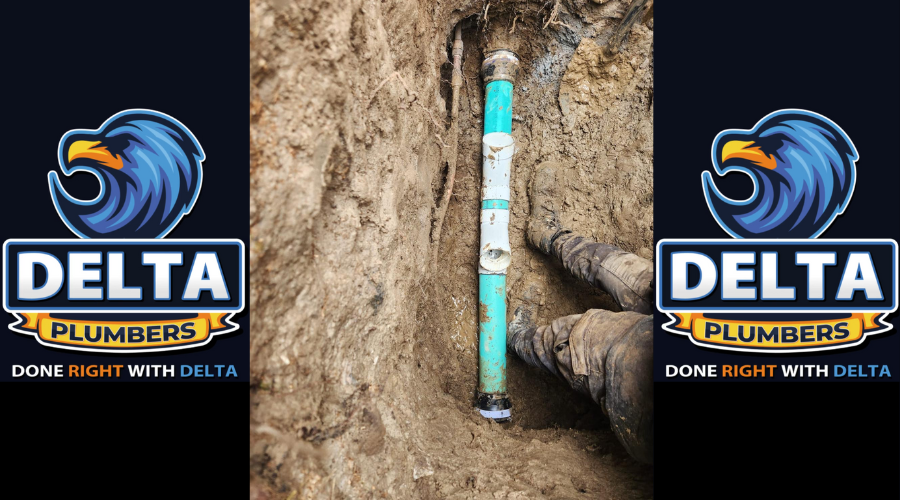In an era where sustainability and environmental consciousness are becoming increasingly important, green plumbing solutions offer a way to reduce your environmental footprint while maintaining the functionality and comfort of your home. By choosing eco-friendly materials and methods, you can contribute to a healthier planet and even save on energy and water costs. This comprehensive guide will explore the best practices for green plumbing, focusing on sustainable materials, the benefits of eco-friendly plumbing, and why certain commonly used materials like PVC should be avoided.

Picture Source – Delta Plumbers
What is the Most Sustainable Plumbing Material?
When considering green plumbing solutions, the choice of materials is paramount. The most sustainable plumbing materials are those that are durable, recyclable, and have minimal impact on the environment. Here are some of the most sustainable options:
Copper:
Copper has been used in plumbing for centuries due to its durability and resistance to corrosion. It’s also one of the most sustainable materials because it can be recycled indefinitely without losing its properties. Copper pipes are long-lasting, reducing the need for frequent replacements and lowering environmental impact over time.
Stainless Steel:
Stainless steel is another highly sustainable option for plumbing. It’s incredibly durable, resistant to corrosion, and can be recycled multiple times. Stainless steel pipes are ideal for both water supply and drainage systems, offering a long service life with minimal maintenance.
Cross-Linked Polyethylene (PEX):
PEX is a plastic material that has gained popularity in green plumbing for its flexibility, durability, and ease of installation. Unlike PVC, PEX is considered more environmentally friendly as it requires less energy to produce and does not release harmful chemicals into the water. Additionally, PEX pipes can be recycled, although the process is not as widespread as with metals like copper.
Brass:
Brass, an alloy of copper and zinc, is another sustainable plumbing material. It is durable, resistant to corrosion, and recyclable. Brass fittings and valves are commonly used in green plumbing systems, especially in areas where water purity is essential.
Choosing the right material for your plumbing system is a crucial step in adopting green plumbing practices. Opting for materials like copper, stainless steel, and PEX can significantly reduce your home’s environmental impact while ensuring a reliable and efficient water supply.
Also Read: Emergency Plumbing Tips: What to Do When You Have a Leak

Picture Source – Delta Plumbers
What are the Benefits of Green Plumbing?
Green plumbing solutions offer numerous benefits, both for the environment and for homeowners. Here are some of the key advantages:
Reduced Water Consumption:
Green plumbing techniques often involve the use of low-flow fixtures, such as faucets, showerheads, and toilets, which can significantly reduce water usage. By using less water, you not only conserve a precious resource but also lower your utility bills.
Energy Efficiency:
Eco-friendly plumbing systems are designed to minimize energy consumption. For instance, tankless water heaters provide hot water on demand, reducing the energy wasted in heating and storing water. Additionally, insulating pipes can prevent heat loss, ensuring that hot water remains at the desired temperature without additional energy use.
Improved Indoor Air Quality:
Traditional plumbing materials like PVC can release volatile organic compounds (VOCs) into the air, which can negatively affect indoor air quality. By choosing non-toxic, sustainable materials, you can create a healthier living environment for your family.
Durability and Longevity:
Green plumbing materials, such as copper and stainless steel, are known for their durability. A longer-lasting plumbing system reduces the need for repairs and replacements, which in turn lowers the demand for new materials and the energy required to produce them.
Waste Reduction:
By choosing recyclable materials and implementing water-saving technologies, green plumbing helps reduce waste. This not only benefits the environment but also supports the circular economy, where materials are reused and recycled rather than discarded.
Financial Savings:
Although green plumbing solutions may have a higher upfront cost, they often lead to significant savings over time. Lower water and energy bills, reduced maintenance costs, and potential tax incentives for eco-friendly home improvements can make green plumbing a financially sound investment.
Positive Environmental Impact:
Perhaps the most significant benefit of green plumbing is its positive impact on the environment. By conserving water, reducing energy consumption, and using sustainable materials, you contribute to the fight against climate change and help protect natural resources for future generations.
Green plumbing is not just a trend; it’s a smart choice for anyone looking to make their home more sustainable and environmentally friendly. The benefits extend beyond your household, contributing to a healthier planet overall.
Also Read: How to Unclog Drains Naturally

Picture Source – Delta Plumbers
What is the Healthiest Material for Water Pipes?
When it comes to choosing the healthiest material for water pipes, safety and purity are the top priorities. The following materials are considered the best options for ensuring clean, safe drinking water:
Copper:
Copper is widely regarded as one of the safest materials for water pipes. It is naturally resistant to bacterial growth and does not release harmful chemicals into the water. Copper pipes have been used for decades and are known for their durability and reliability. Additionally, copper is recyclable, making it a sustainable choice for plumbing systems.
Stainless Steel:
Stainless steel is another excellent choice for water pipes. It is highly resistant to corrosion and does not leach chemicals into the water. Stainless steel pipes are particularly suitable for areas with aggressive water conditions, as they can withstand exposure to various chemicals and temperatures without degrading. Moreover, stainless steel is a recyclable material, adding to its environmental benefits.
PEX:
Cross-linked polyethylene (PEX) is a flexible plastic material that is gaining popularity as a safe alternative to traditional metal pipes. PEX is resistant to corrosion and scale buildup, and it does not leach harmful chemicals into the water. While it is not as recyclable as copper or stainless steel, PEX is still considered a safe option for drinking water due to its non-toxic properties.
Brass:
Brass fittings and valves are commonly used in plumbing systems and are considered safe for drinking water. This is an alloy of copper and zinc, both of which are non-toxic and do not pose significant health risks. However, it’s essential to choose lead-free brass fittings to avoid any potential contamination.
When selecting the healthiest material for water pipes, it’s crucial to consider both the safety of the material and its environmental impact. Copper, stainless steel, and PEX are all excellent choices that offer a balance of safety, durability, and sustainability.
Also Read: Right Plumber for Your Needs: How to Choose Best

Picture Source – Delta Plumbers
How Do You Clean Green Pipes?
Maintaining clean pipes is essential for ensuring the efficiency and longevity of your plumbing system. For those committed to green plumbing practices, it’s important to use eco-friendly methods and products to clean pipes. Here are some effective ways to keep your pipes clean while staying true to green principles:
Natural Drain Cleaners:
Instead of using harsh chemical drain cleaners, which can damage pipes and harm the environment, opt for natural alternatives. A simple mixture of baking soda and vinegar can effectively clear minor clogs and clean pipes. Pour half a cup of baking soda down the drain, followed by half a cup of vinegar. Let the mixture sit for 15-30 minutes, then flush with hot water.
Enzyme-Based Cleaners:
Enzyme-based drain cleaners are a green alternative to chemical cleaners. These products use natural enzymes and bacteria to break down organic matter in pipes, effectively clearing clogs without harming the environment. Enzyme-based cleaners are safe for all types of plumbing and are biodegradable, making them an excellent choice for eco-conscious homeowners.
Regular Maintenance:
Preventative maintenance is key to keeping your pipes clean and avoiding clogs. Regularly flushing your pipes with hot water can help remove buildup and prevent blockages. Additionally, using a drain strainer in sinks and showers can catch debris before it enters the pipes, reducing the risk of clogs.
Hydro Jetting:
For more severe clogs or buildup, hydro jetting is an eco-friendly option. This method uses high-pressure water to clean the inside of pipes, removing debris, grease, and scale without the need for chemicals. Hydro jetting is highly effective and safe for the environment, as it only uses water.
Avoid Grease and Food Waste:
One of the best ways to keep your pipes clean is to avoid putting grease and food waste down the drain. Grease can solidify in pipes, leading to clogs and blockages. Instead, dispose of grease in a container and throw it in the trash. Compost food waste or use a garbage disposal sparingly to minimize the risk of clogs.
By adopting these green cleaning methods, you can maintain a healthy plumbing system while minimizing your impact on the environment. Regular maintenance and the use of natural, eco-friendly products are essential for ensuring that your pipes remain clean and efficient.
Also Read: Signs You Need to Replace Your Plumbing Pipes

Picture Source – Delta Plumbers
Is PEX Safe for Drinking Water?
Cross-linked polyethylene (PEX) is a flexible plastic material that has become increasingly popular in plumbing systems. When it comes to safety, particularly for drinking water, PEX is considered a safe option for several reasons:
Non-Toxic Material:
PEX is made from high-density polyethylene, a material that does not release harmful chemicals into the water. Unlike PVC, which can leach chemicals like phthalates and chlorine, PEX is free from toxic additives and is considered safe for transporting drinking water.
Resistance to Corrosion and Scale:
One of the key benefits of PEX is its resistance to corrosion and scale buildup. Unlike metal pipes, which can corrode and introduce metals into the water, PEX remains chemically stable and does not react with water or other substances. This ensures that the water remains clean and free from contaminants.
No Risk of Lead Contamination:
Lead contamination is a serious concern with older plumbing systems, particularly those using lead pipes or solder. PEX pipes do not contain lead, eliminating the risk of lead leaching into the water supply. This makes PEX a safer choice for homes, especially those with young children or individuals with compromised immune systems.
Approval by Health Authorities:
PEX has been extensively tested and approved by various health authorities, including the National Sanitation Foundation (NSF) and the U.S. Environmental Protection Agency (EPA). These organizations have determined that PEX meets the safety standards for drinking water applications, providing peace of mind to homeowners.
Durability and Longevity:
PEX is known for its durability and long lifespan. It can withstand extreme temperatures and is less likely to burst in freezing conditions compared to traditional materials like copper. The longevity of PEX reduces the need for frequent replacements, minimizing the environmental impact over time.
Minimal Taste and Odor Issues:
Some homeowners have reported a slight plastic taste or odor when PEX pipes are first installed. However, this issue typically resolves after a short period of use. Flushing the pipes thoroughly before use can help eliminate any initial taste or odor concerns.
While PEX is generally considered safe for drinking water, it’s essential to choose high-quality PEX pipes from reputable manufacturers to ensure the best performance and safety. By doing so, you can enjoy the benefits of PEX without compromising the quality of your drinking water.
Conclusion
Green plumbing solutions offer a practical and effective way to make your home more sustainable while enjoying numerous benefits, from reduced water and energy consumption to improved indoor air quality and financial savings. By choosing eco-friendly materials like copper, stainless steel, and PEX, and avoiding harmful options like PVC, you can ensure that your plumbing system is both safe and environmentally responsible.
Incorporating green plumbing practices into your home not only contributes to a healthier planet but also provides long-term value and peace of mind. Whether you’re building a new home or upgrading an existing system, the choices you make today can have a lasting impact on your home’s efficiency, your family’s health, and the environment.
At Delta Plumbers, we are committed to helping you find the best green plumbing solutions for your needs. Contact us today to learn more about how we can assist you in creating a sustainable, eco-friendly home.









